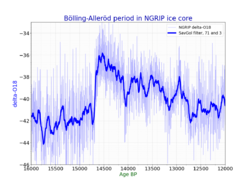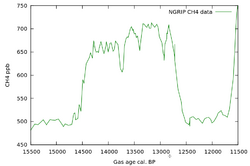Earth:Bølling–Allerød warming

The Bølling–Allerød interstadial (Danish: [ˈpøle̝ŋ ˈæləˌʁœðˀ]), also called the Late Glacial Interstadial, was an abrupt warm and moist interstadial period that occurred during the final stages of the Last Glacial Period. This warm period ran from 14,690 to 12,890 years before the present (BP).[2] It began with the end of the cold period known as the Oldest Dryas, and ended abruptly with the onset of the Younger Dryas, a cold period that reduced temperatures back to near-glacial levels within a decade.[3]
In some regions, a cold period known as the Older Dryas can be detected in the middle of the Bølling–Allerød interstadial. In these regions the period is divided into the Bølling oscillation, which peaked around 14,500 BP, and the Allerød oscillation, which peaked closer to 13,000 BP.
History

In 1901, the Danish geologists Nikolaj Hartz (1867–1937) and Vilhelm Milthers (1865–1962) provided evidence for climatic warming during the last glacial period, sourced from a clay-pit near Allerød, Denmark .[4][5]
Effects
It has been postulated that teleconnections, oceanic and atmospheric processes, on different timescales, connect both hemispheres during abrupt climate change.[6] The Bølling–Allerød was almost completely synchronous across the Northern Hemisphere.[7]
The Meltwater pulse 1A event coincides with or closely follows the abrupt onset of the Bølling–Allerød (BA), when global sea level rose about 16 m during this event at rates of 26–53 mm/yr.[8]
Records obtained from the Gulf of Alaska show abrupt sea-surface warming of about 3 °C (in less than 90 years), matching ice-core records that register this transition as occurring within decades.[9] Antarctic Intermediate Water (AAIW) cooled slightly during this interstadial.[10]
δ18O records from Valmiki Cave in southern India indicate extreme shifts in Indian Summer Monsoon intensity at Termination 1a, which marks the start of the Bølling–Allerød and occurred about 14,800 BP.[11]
Scientists from the Center for Arctic Gas Hydrate (CAGE), Environment and Climate at the University of Tromsø, published a study in June 2017, describing over a hundred ocean sediment craters, some 3,000 meters wide and up to 300 meters deep, formed due to explosive eruptions, attributed to destabilizing methane hydrates, following ice-sheet retreat during the last glacial period, around 12,000 years ago, a few centuries after the Bølling–Allerød warming. These areas around the Barents Sea still seep methane today, and still-existing bulges with methane reservoirs could eventually have the same fate.[12]
Ice-sheet retreat
A 2017 study attributed the second Weichselian Icelandic ice sheet collapse, onshore (est. net wastage 221 Gt a−1[clarification needed] over 750 years) and similar to today's Greenland rates of mass loss, to atmospheric Bølling–Allerød warming. The study's authors noted:
Geothermal conditions impart a significant control on the ice sheet's transient response, particularly during phases of rapid retreat. Insights from this study suggests that large sectors of contemporary ice sheets overlying geothermally active regions, such as Siple Coast, Antarctica, and northeastern Greenland, have the potential to experience rapid phases of mass loss and deglaciation once initial retreat is initiated.[13]
The melting of the glaciers of Hardangerfjord began during this interstadial. Boknafjord had already begun to deglaciate before the onset of the Bølling–Allerød interstadial.[14]
Flora
Ice uncovered large parts of north Europe and temperate forests covered Europe from N 29° to 41° latitude. Pioneer vegetation, such as Salix polaris and Dryas octopetala, began to grow in regions that were previously too cold to support these plants. Later, mixed evergreen and deciduous forests prevailed in Eurasia, more deciduous toward the south, just as today. Birch, aspen, spruce, pine, larch and juniper were to be found extensively, mixed with Quercus and Corylus. Poaceae was to be found in more open regions.
Fauna
During this time late Pleistocene animals spread northward from refugia in the three peninsulas, Iberian Peninsula, Italy and the Balkans. Geneticists can identify the general location by studying degrees of consanguinity in the modern animals of Europe. Many animal species were able to move into regions far more northerly than they could have survived in during the preceding colder periods. Reindeer, horse, saiga, antelope, bison, woolly mammoth and woolly rhinoceros were attested, and were hunted by early man. In the alpine regions ibex and chamois were hunted. Throughout the forest were red deer. Smaller animals, such as fox, wolf, hare and squirrel also appear. Salmon was fished. When this interstadial period ended, with the onset of the Younger Dryas, many of these species were forced to migrate south or become regionally extinct.
In the Great Barrier Reef, the Bølling–Allerød warming is associated with a substantial accumulation of calcium carbonate.[15]
Causes
Ocean circulation
In recent years research tied the Bølling–Allerød warming to the release of heat from warm waters originating from the deep North Atlantic Ocean, possibly triggered by a strengthening of the Atlantic meridional overturning circulation (AMOC) at the time.[16][17]
Study results which would help to explain the abruptness of the Bølling–Allerød warming, based on observations and simulations, found that 3°–5 °C Ocean warming occurred at intermediate depths in the North Atlantic over several millennia during Heinrich stadial 1 (HS1). The authors postulated that this warm salty water (WSW) layer, situated beneath the colder surface freshwater in the North Atlantic, generated ocean convective available potential energy (OCAPE) over decades at the end of HS1. According to fluid modelling, at one point the accumulation of OCAPE was released abruptly (c. 1 month) into kinetic energy of thermobaric cabbeling convection (TCC), resulting in the warmer salty waters getting to the surface and subsequently warming the sea surface by approximately 2 °C.[18]
Volcanism
Isostatic rebound in response to glacier retreat (unloading) and an increase in local salinity (i.e., δ18Osw) have been attributed to increased volcanic activity at the onset of Bølling–Allerød. The association with the interval of intense volcanic activity hints at an interaction between climate and volcanism, with one possible route being enhanced short-term melting of glaciers via albedo changes from particle fallout on glacier surfaces.[9]
Greenhouse gases
Estimates of CO
2 rise during this interstadial are 20–35 ppmv within 200 years, a rate less than 29–50% compared to the anthropogenic global warming signal from the past 50 years, and with a radiative forcing of 0.59–0.75 W m−2.[19] A previously unidentified contributor to atmospheric CO
2 was the expansion of Antarctic Intermediate Water, which is poor at sequestering the gas.[20]
Human cultures
Humans reentered the forests of Europe in search of big game to hunt. Some theories suggest that humans as well as the changing climate were the driving force that led many of these species to extinction. Their cultures were the last of the Late Upper Palaeolithic. Magdalenian hunters moved up the Loire into the Paris Basin. In the drainage basin of the Dordogne, the Perigordian prevailed. The Epigravettian dominated Italy. In the north, the Hamburgian and Federmesser cultures are found. The Lyngby, Bromme, Ahrensburg and Swiderian were also attested in Europe at this time. To the south and far east the Neolithic had already begun. In the Middle East, the pre-agricultural Natufian settled around the Eastern Mediterranean coast to exploit wild cereals, such as emmer and two-row barley. In the Allerød they would begin to domesticate these plants.
See also
- Abrupt climate change
- African humid period
- Antarctic Cold Reversal
- Dansgaard–Oeschger event
- Hiawatha Glacier
- Ice age
Sources
- ↑ Zalloua, Pierre A.; Matisoo-Smith, Elizabeth (6 January 2017). "Mapping Post-Glacial expansions: The Peopling of Southwest Asia" (in en). Scientific Reports 7: 40338. doi:10.1038/srep40338. ISSN 2045-2322. PMID 28059138. Bibcode: 2017NatSR...740338P.
- ↑ Rasmussen, S. O.; Andersen, K. K.; Svensson, A. M.; Steffensen, J. P.; Vinther, B. M.; Clausen, H. B.; Siggaard-Andersen, M.-L.; Johnsen, S. J. et al. (2006). "A new Greenland ice core chronology for the last glacial termination" (in en). Journal of Geophysical Research 111 (D6): D06102. doi:10.1029/2005JD006079. ISSN 0148-0227. Bibcode: 2006JGRD..111.6102R.
- ↑ Wade, Nicholas (2006). Before the Dawn. New York: Penguin Press. p. 123. ISBN 978-1-59420-079-3.
- ↑ Wim Z. Hoek (2009). "Bølling-Allerød Interstadial". Encyclopedia of Paleoclimatology and Ancient Environments. Encyclopedia of Earth Sciences Series. Encyclopedia of Earth Sciences Series. pp. 100–103. doi:10.1007/978-1-4020-4411-3_26. ISBN 978-1-4020-4551-6.
- ↑ Hartz, N.; Milthers, V. (1901). "Det senglaciale Ler i Allerød Teglværkgrav" (in Danish). Meddelelser Fra Dansk Geologisk Forening (Bulletin of the Geological Society of Denmark) 2 (8): 31–60. https://babel.hathitrust.org/cgi/pt?id=inu.32000004344760&view=1up&seq=247.
- ↑ Markle (2016). "Global atmospheric teleconnections during Dansgaard–Oeschger events". Nature Geoscience 10: 36–40. doi:10.1038/ngeo2848.
- ↑ Benson, Larry; Burdett, James; Lund, Steve; Kashgarian, Michaele; Mensing, Scott (17 July 1997). "Nearly synchronous climate change in the Northern Hemisphere during the last glacial termination" (in en). Nature 388 (6639): 263–265. doi:10.1038/40838. ISSN 1476-4687. https://www.nature.com/articles/40838. Retrieved 29 September 2023.
- ↑ Gornitz (2012). "The Great Ice Meltdown and Rising Seas: Lessons for Tomorrow". NASA. https://www.giss.nasa.gov/research/briefs/gornitz_10/.
- ↑ 9.0 9.1 Praetorius (2016). "Interaction between climate, volcanism, and isostatic rebound in Southeast Alaska during the last deglaciation". Earth and Planetary Science Letters 452: 79–89. doi:10.1016/j.epsl.2016.07.033. Bibcode: 2016E&PSL.452...79P. https://www.researchgate.net/publication/306418361.
- ↑ Stewart, Joseph A.; Robinson, Laura F.; Rae, James W. B.; Burke, Andrea; Chen, Tianyu; Li, Tao; de Carvalho Ferreira, Maria Luiza; Fornari, Daniel J. (16 December 2023). "Arctic and Antarctic forcing of ocean interior warming during the last deglaciation" (in en). Scientific Reports 13 (1). doi:10.1038/s41598-023-49435-0. ISSN 2045-2322. PMID 38104174. PMC 10725493. https://www.nature.com/articles/s41598-023-49435-0. Retrieved 1 January 2024.
- ↑ Lone, Mahjoor Ahmad; Ahmad, Syed Masood; Dung, Nguyen Chi; Shen, Chuan-Chou; Raza, Waseem; Kumar, Anil (1 February 2014). "Speleothem based 1000-year high resolution record of Indian monsoon variability during the last deglaciation". Palaeogeography, Palaeoclimatology, Palaeoecology 395: 1–8. doi:10.1016/j.palaeo.2013.12.010. ISSN 0031-0182. https://www.sciencedirect.com/science/article/pii/S0031018213005403. Retrieved 1 January 2024.
- ↑ "Like 'champagne bottles being opened': Scientists document an ancient Arctic methane explosion". The Washington Post. June 1, 2017. https://www.washingtonpost.com/news/energy-environment/wp/2017/06/01/like-champagne-bottles-being-opened-scientists-document-an-ancient-arctic-methane-explosion.
- ↑ Patton (2017). "The configuration, sensitivity and rapid retreat of the Late Weichselian Icelandic ice sheet". Earth-Science Reviews 166: 223–245. doi:10.1016/j.earscirev.2017.02.001. Bibcode: 2017ESRv..166..223P. http://dspace.stir.ac.uk/bitstream/1893/25102/1/PATTON_etal_ESR2017_AcceptedMS_LoRes.pdf.
- ↑ Gump, Dale J.; Briner, Jason P.; Mangerud, Jan; Svendsen, John Inge (6 January 2017). "Deglaciation of Boknafjorden, south-western Norway: DEGLACIATION OF BOKNAFJORDEN, SW NORWAY" (in en). Journal of Quaternary Science 32 (1): 80–90. doi:10.1002/jqs.2925. https://onlinelibrary.wiley.com/doi/10.1002/jqs.2925. Retrieved 29 September 2023.
- ↑ Hinestrosa, Gustavo; Webster, Jody M.; Beaman, Robin J. (18 January 2022). "New constraints on the postglacial shallow-water carbonate accumulation in the Great Barrier Reef" (in en). Scientific Reports 12 (1): 924. doi:10.1038/s41598-021-04586-w. ISSN 2045-2322. PMC 8766595. https://www.nature.com/articles/s41598-021-04586-w. Retrieved 29 September 2023.
- ↑ Thiagarajan (2014). "Abrupt pre-Bølling–Allerød warming and circulation changes in the deep ocean". Nature 511 (7507): 75–78. doi:10.1038/nature13472. PMID 24990748. Bibcode: 2014Natur.511...75T. http://web.gps.caltech.edu/~jess/ThiagarajanNature2014.pdf.
- ↑ Lohmann (2016). "Abrupt climate change experiments: the role of freshwater, ice sheets and deglacial warming for the Atlantic Meridional Overturning Circulation". Polarforschung. doi:10.2312/polfor.2016.013. http://epic.awi.de/41137/1/polfor_2016_013.pdf.
- ↑ Su (2016). "On the Abruptness of Bølling–Allerød Warming". Journal of Climate 29 (13): 4965–4975. doi:10.1175/JCLI-D-15-0675.1. Bibcode: 2016JCli...29.4965S. https://authors.library.caltech.edu/69284/1/jcli-d-15-0675.1.pdf.
- ↑ Köhler (2011). "Abrupt rise in atmospheric CO2 at the onset of the Bølling/Allerød: in-situ ice core data versus true atmospheric signals". Climate of the Past 7 (2): 473–486. doi:10.5194/cp-7-473-2011. Bibcode: 2011CliPa...7..473K.
- ↑ Yu, Jimin; Oppo, Delia W.; Jin, Zhangdong; Lacerra, Matthew; Umling, Natalie E.; Lund, David C.; McCave, Nick; Menviel, Laurie et al. (17 March 2022). "Millennial and centennial CO2 release from the Southern Ocean during the last deglaciation". Nature Geoscience 15 (4): 293–299. doi:10.1038/s41561-022-00910-9. Bibcode: 2022NatGe..15..293Y. https://risweb.st-andrews.ac.uk/portal/en/researchoutput/millennial-and-centennial-co2-release-from-the-southern-ocean-during-the-last-deglaciation(f126d5cd-7b1f-473e-a5ea-b023f4bb7e2a).html. Retrieved 21 January 2023.
External links
- Sensitivity and rapidity of vegetational response to abrupt climate change
- Climate change clues revealed by ice sheet collapse
 |



